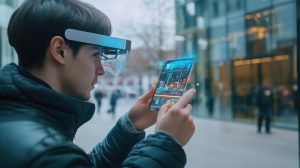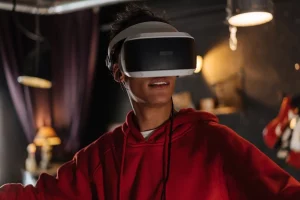
The Impact of Augmented Reality: Revolutionizing Industries and Enhancing User Experiences
Augmented Reality (AR) is rapidly transforming the way businesses engage with consumers and how industries operate. With its ability to overlay digital information onto the physical world, AR provides immersive, interactive experiences that are reshaping sectors from retail and healthcare to automotive and gaming. In this article, we will explore how AR is being applied across various fields, examine the benefits of this technology, and look at real-world case studies that illustrate its growing impact.
What is Augmented Reality?

Augmented Reality is a technology that enhances the physical environment by overlaying digital elements such as images, sounds, and other sensory inputs in real time. Unlike Virtual Reality (VR), which creates an entirely digital environment, AR enhances the real world without replacing it. AR applications can be accessed through devices like smartphones, tablets, AR glasses, and even vehicle heads-up displays.
The Growing Role of Augmented Reality in Various Sectors
AR is being adopted across industries due to its ability to enhance user interaction, streamline operations, and improve decision-making processes. Here’s how AR is being used in several key industries:
1. Augmented Reality in Retail and eCommerce
One of the most notable applications of AR is in retail and eCommerce. AR is revolutionizing the online shopping experience by allowing customers to virtually “try on” products, from clothing to makeup and furniture, in real time. This not only enhances the shopping experience but also reduces return rates, as customers can see how products look in their environment before making a purchase.
Example: IKEA’s AR Application
IKEA’s AR app allows users to place virtual furniture in their homes using just their smartphones. This WebAR development platform enables customers to visualize how items like sofas, tables, or bookshelves will fit in their living spaces before making a purchase, reducing the uncertainty associated with online shopping.
2. AR for Indoor Navigation Systems
AR has also proven useful for indoor navigation in complex spaces such as airports, hospitals, and large shopping malls. Marker-based AR indoor navigation can provide real-time guidance, making it easier for users to find their way.
Example: Gatwick Airport
Gatwick Airport in London implemented an AR-based navigation tool that helps passengers find check-in counters, gates, and baggage claim areas. By simply holding up their smartphones, travelers can see arrows and directions overlayed on their surroundings, offering a seamless navigation experience.
3. Augmented Reality in Healthcare for Surgical Procedures
Healthcare is another industry that has embraced AR to enhance patient care and improve outcomes. Augmented reality in healthcare for surgical procedures allows surgeons to overlay critical information, such as CT scans or MRI images, directly onto a patient’s body in real time. This can improve the precision of surgeries and reduce risks.
Case Study: Google’s Augmented Reality Microscope
Google’s Augmented Reality Microscope has been developed to assist pathologists in diagnosing diseases like cancer. The AR-powered microscope overlays digital images of tissue samples, highlighting potential areas of concern and improving the accuracy of diagnoses.
4. AR in Automotive Industry Applications
AR is transforming the automotive industry by enhancing both the driving experience and vehicle manufacturing processes. From AR-powered automotive sales tools that help customers explore car features in real time to AR-based quality control in manufacturing, this technology is playing a vital role.
Example: BMW’s Heads-Up Display
BMW has integrated AR into its vehicle heads-up displays, allowing drivers to see important navigation information and speed data directly on their windshield. This reduces distractions by keeping the driver’s attention on the road, improving safety and enhancing the overall driving experience.
5. AR in Gaming: The Rise of Mixed Reality Games

Gaming has long been at the forefront of AR innovation, and mixed reality games for Meta Quest devices are the latest evolution of this trend. AR adds another layer to traditional video games by blending the real world with the digital, creating an immersive and interactive experience.
Example: Pokémon Go
Pokémon Go is one of the most successful AR-based games ever created. The game allows players to interact with virtual Pokémon in the real world through their smartphones, using GPS and camera functionality to create an engaging mixed-reality experience.
6. Web-Based Augmented Reality (WebAR) Experiences
WebAR refers to AR experiences that can be accessed through a web browser without the need for downloading an app. This makes AR more accessible to a broader audience, as users can engage with augmented content using their existing devices.
Example: AR in Marketing Campaigns
Brands are increasingly using AR-enhanced marketing campaigns to engage consumers. PepsiCo created an AR experience for its “Pepsi Max” campaign, allowing users to interact with virtual characters and special effects by scanning a QR code on their mobile phones.
7. Augmented Reality in Physical Therapy and Rehabilitation
AR is now being used in healthcare beyond surgery, specifically in physical therapy and rehabilitation. This technology allows therapists to create customized, interactive exercises for patients recovering from injuries or surgeries. Augmented reality heads-up displays provide real-time feedback, ensuring that patients perform their exercises correctly.
Case Study: Augmented Reality for Stroke Recovery
A recent case study demonstrated the effectiveness of AR-based physical therapy for stroke survivors. Patients using AR for rehabilitation exercises showed faster recovery times and improved motor function, as the technology made the exercises more engaging and precise.
Benefits of Augmented Reality
AR technology offers numerous benefits to businesses and consumers alike, including:
1. Enhanced Customer Engagement
AR allows for a more interactive and personalized experience, which increases customer engagement. In retail, for instance, AR virtual try-on technology allows users to experiment with products before making a purchase, leading to higher customer satisfaction.
2. Improved Operational Efficiency
In industries like manufacturing, AR-based quality control systems help identify defects in products before they leave the factory. This leads to fewer recalls, reduced waste, and improved overall efficiency.
3. Cost Reduction
By providing virtual prototypes and simulations, AR reduces the need for physical models and testing in industries such as automotive and construction, thereby saving time and money.
4. Better Learning and Training
AR is widely used in educational settings and professional training programs. From healthcare professionals learning surgical techniques to automotive technicians receiving training on new vehicles, AR offers immersive learning experiences that improve knowledge retention.
5. Enhanced Decision Making
In fields like healthcare, AR allows professionals to visualize complex data in real-time, aiding in more accurate diagnoses and treatment decisions. For example, surgeons can use AR to view a patient’s anatomy during a procedure, improving precision.
Challenges of Augmented Reality
Despite its numerous advantages, AR does face some challenges, including:
- High Development Costs: Developing AR applications, especially those requiring advanced hardware or software, can be expensive.
- Privacy Concerns: AR applications that collect and process real-world data raise privacy concerns, especially in public spaces.
- Limited Device Compatibility: Not all devices are equipped to handle AR applications, limiting accessibility for some users.
Conclusion
Augmented reality is no longer a futuristic technology; it’s here and transforming industries across the board. From improving customer engagement in retail to enhancing healthcare outcomes and optimizing manufacturing processes, AR is revolutionizing the way we interact with the world. As the technology continues to evolve, with developments in WebAR and AR-powered tools like Google’s Augmented Reality Microscope, its potential is only just beginning to be realized.
The growing role of AR in sectors such as retail, healthcare, automotive, and gaming highlights its versatility and power. As more businesses adopt AR, its impact on improving operational efficiency, enhancing decision-making, and engaging consumers will only expand. AR truly represents the next frontier of digital innovation, with its applications continuing to redefine the boundaries of what is possible.










